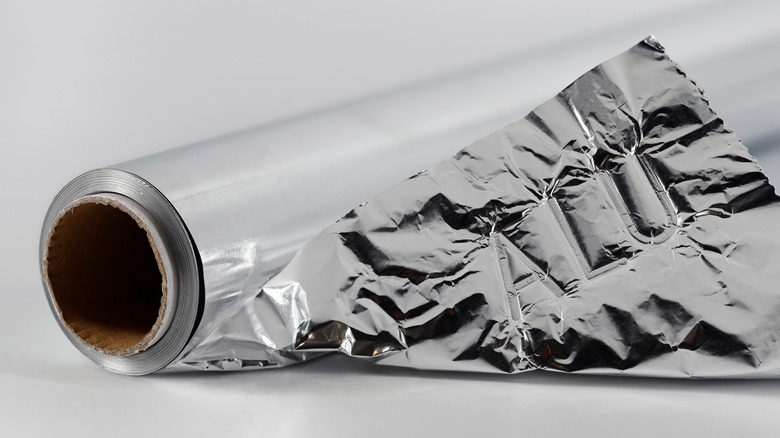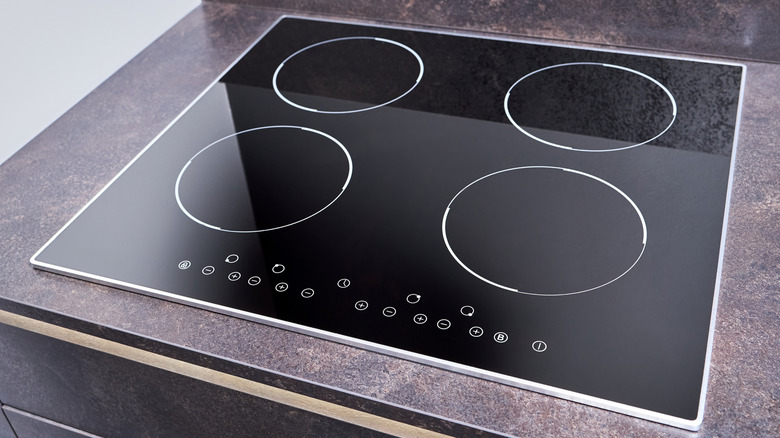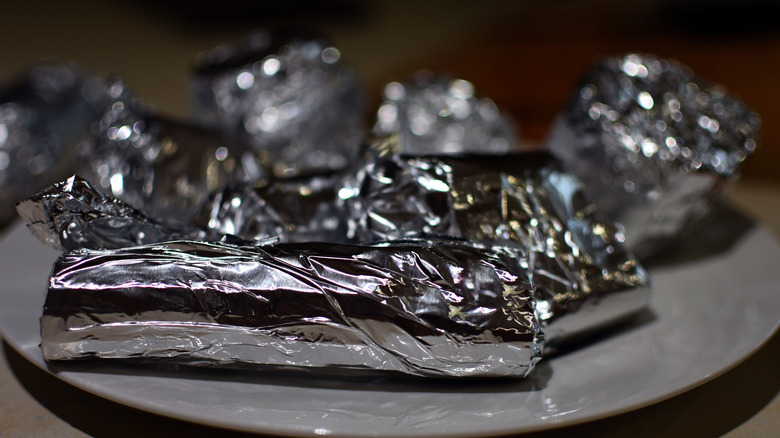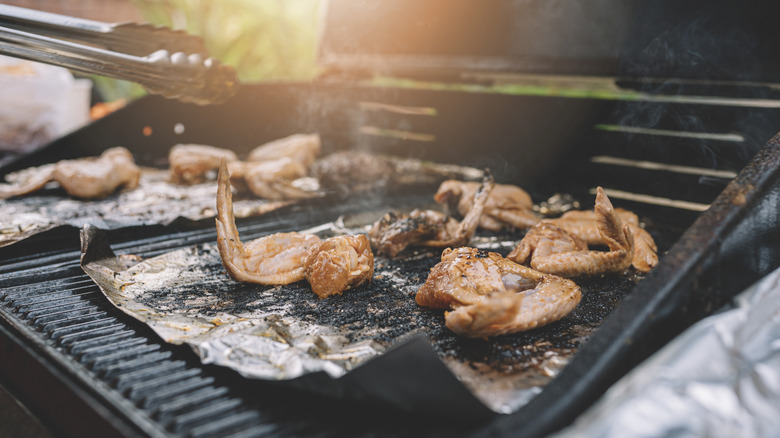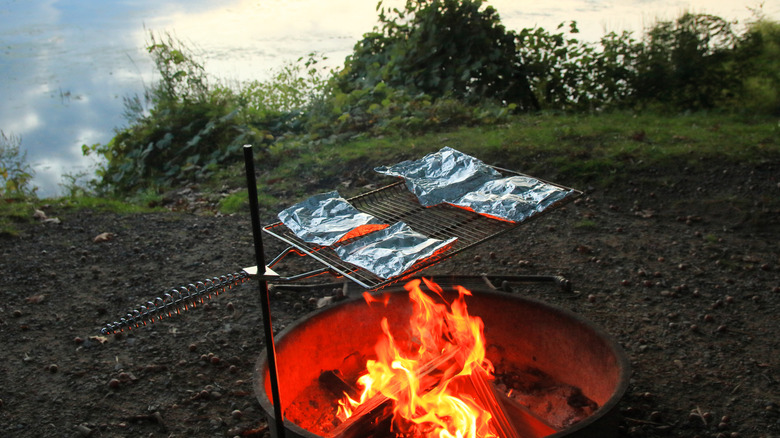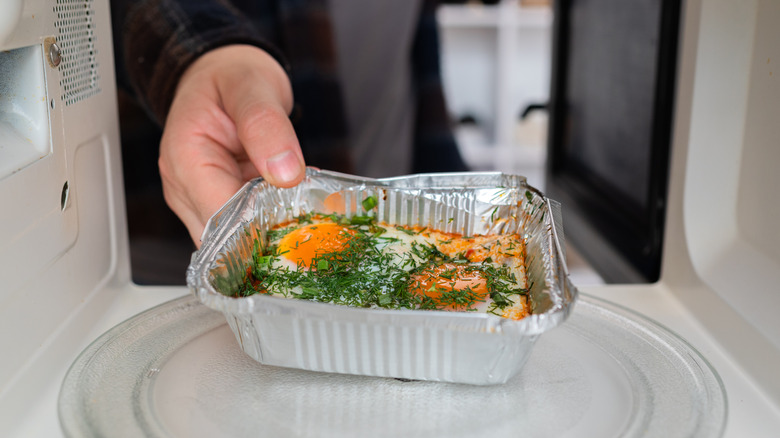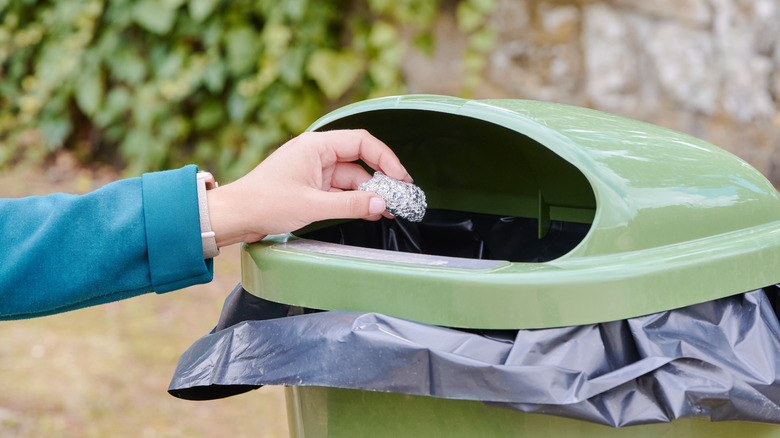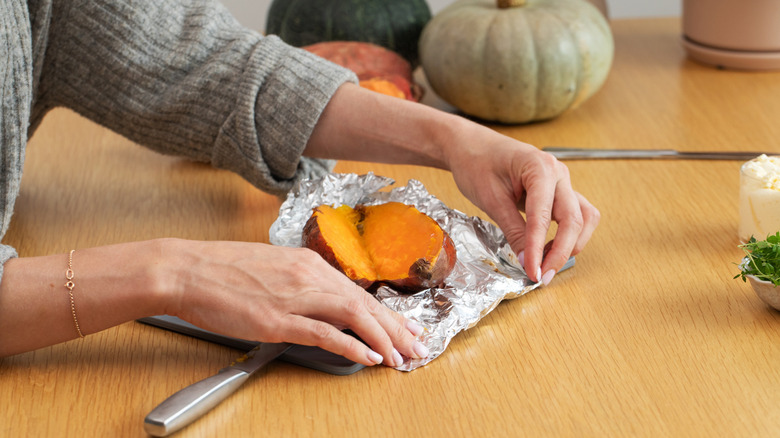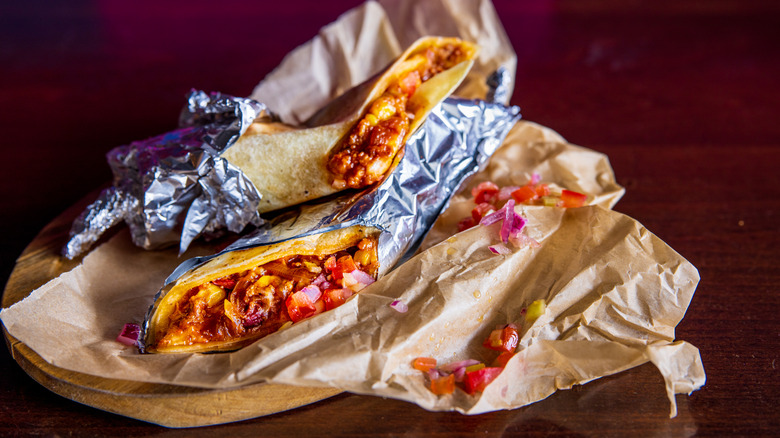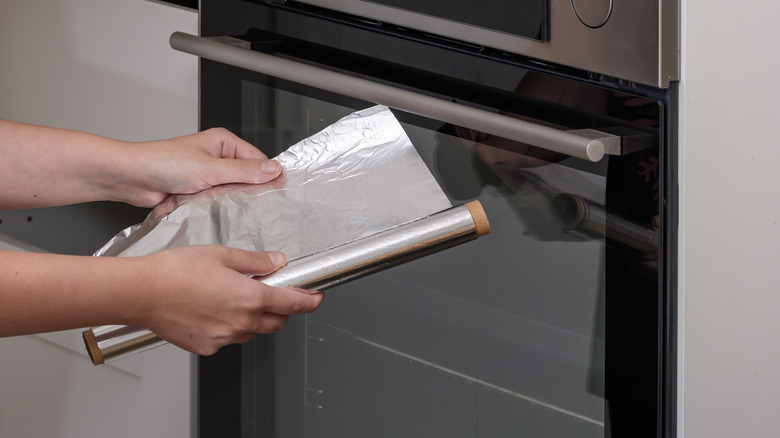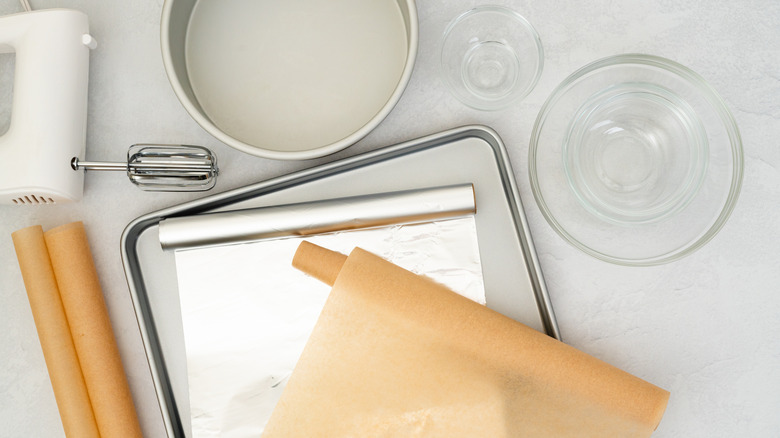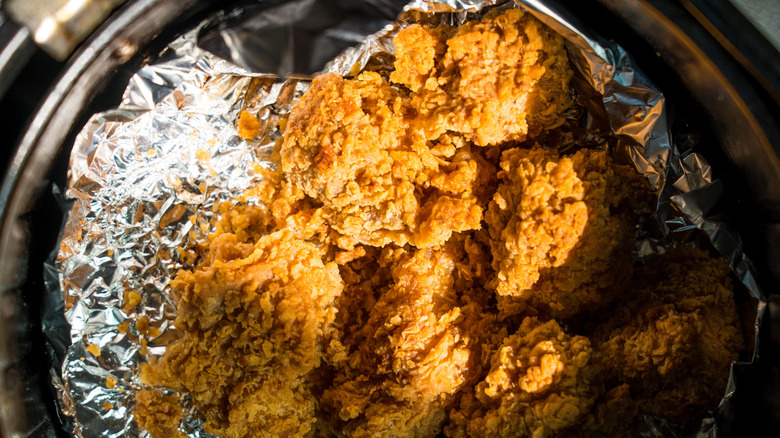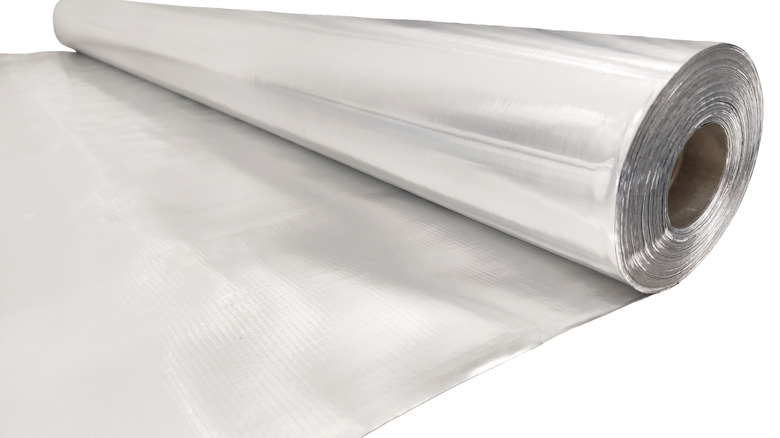12 Mistakes You're Making With Aluminum Foil
Aluminum foil is a versatile essential with numerous uses, both in and out of the kitchen. From cooking and baking to cleaning silverware, aluminum foil can be used far beyond mere food prep. Campers use it to fashion makeshift utensils to cook with, gardeners rely on it to protect plants from aphids, and aluminum foil can even be used to help loose batteries fit snugly into their compartments. Versatile indeed!
It's in the kitchen, however, that aluminum foil truly shines (pun not intended!). Its adaptability lies in its ability to be molded into any shape to be used as a liner, a pouch, a tent, or a wrapper. It is also impressively durable and can be used many times over. But along with its many uses, there are quite a few mistakes that people make while using aluminum foil. Whether you're cooking, cleaning, or using it around the house, there are a few things foil was never meant for. Here's a look at some common trip-ups you should avoid.
Lining your induction stove with aluminum foil
There are several common mistakes first-time induction stove users make, and one of them is lining the stove with aluminum foil in a bid to keep it clean. While this may prove useful in case of a conventional gas stove to make lighter work of cleanups, in the case of an induction stove, this can prove to be a disaster. To understand why, one needs to understand the physics behind an induction stove's operation. These types of stoves work by creating an oscillating magnetic field just below the glass surface. This magnetic field interacts with the magnetic base of compatible cookware to generate currents that heat the pan. These stoves heat up quite rapidly and efficiently, which accounts for their popularity.
Adding aluminum foil to the surface in an effort to keep it clean can prove to be counterproductive. In the first place, aluminum is non-magnetic, which means it will interfere with the interaction between the magnetic field and the cookware. In effect, the pan will heat up unevenly, if it heats up at all. The real danger is also that the aluminum foil might melt and stick to the glass of the stove, and thereby ruin it. There is also a risk of the foil catching fire, causing the aluminum to release noxious fumes, neither of which you want happening in your kitchen. So, in the interest of safety, just don't line your induction stove with aluminum foil.
Excessively using aluminum foil
A habit many people fall into when it comes to aluminum foil is to use it extensively around the house, without really understanding the environmental impact involved. To deep dive, we need to understand the process of extracting aluminum from its ore, bauxite. This calls for vast mining operations that leave deep scars in the earth's surface and have a lasting impact. Refining the bauxite is extremely energy-intensive and leaves a huge carbon footprint, apart from the toxic waste that is produced, which must then be dealt with. And to top it off, aluminum foil contributes greatly to the household waste that is generated, since recycling it isn't a straightforward process.
While we are not suggesting that you give up using aluminum foil entirely, it is important to be mindful of the ways in which we use it. For example, it would be helpful to stop using it for single-use applications. One could use containers made with recyclable materials, such as beeswax wraps to store food in, or use baking paper or silicone covers instead of aluminum foil to cover pots. This will cut down on our environmental footprint. Making these small adjustments to our consumption habits may seem small, but the cumulative result, if enough people adopt them, can be substantial.
Grilling with aluminum foil is a dangerous proposition
We're sure you haven't thought twice about using aluminum foil when grilling, but it can prove to be hazardous to health and is best avoided. The reason is pretty straightforward: Studies have suggested that heating foil to high temperatures can result in the release of small amounts of aluminum into your food. This aluminum is then ingested, raising the level of the metal in your body. The aluminum levels could increase by a large amount depending on the type of food being cooked, and can prove particularly risky in the case of small children and young adults, as well as for individuals with certain health conditions.
Aluminum exposure has been linked to several serious illnesses, including Alzheimer's disease, Parkinson's disease, breast cancer, and more. Aluminum is considered to be a neurotoxin, and aluminum salts can accumulate in the gut and different tissues, affecting the growth rate of human brain cells and overall health. Health concerns apart, though, another reason to avoid grilling with aluminum foil is that your food may not cook evenly. High heat increases the amount of aluminum that leaches into food, especially when it's acidic or salty. So, while the convenience aluminum foil offers for grilling is indisputable (especially when it comes to cleaning and easy serving), its health concerns more than negate any potential benefit. It is safer to use alternatives such as parchment paper instead.
Using foil near a naked flame
If you, like many others, believe that aluminum foil, as a metal, won't burn and can be safely kept on or near a flame, think again. While it may seem convenient to use foil on a grill to cook or reheat food, these sheets are not designed for direct flame exposure. When heated over an open flame, the foil will release toxic fumes or particles that may be inhaled or end up in your food. Either way, aluminum will be ingested, which can pose health risks. The regular household foil that is used is especially thin and is more prone to this, so it's best to keep it away from an open flame or opt for a thicker foil instead.
There is also a possibility that the aluminum foil may catch fire, though this is rare and unlikely to occur in most home kitchens, leading to uneven cooking as a result of blocked airflow around the item being cooked. So, if you are using aluminum foil to cook during a camping trip, it would be better to use a heavier grade of aluminum foil, which will be resistant to both the leeching effect that occurs in the thinner varieties and to catching fire. The best policy, however, is to avoid direct flame exposure completely.
Never use aluminum foil in the microwave
This one is a no-brainer, yet it is surprisingly one of the more frequent mistakes that people make. Every microwave comes with an instruction booklet that very clearly states, "Do not put metal objects in the microwave". And there's a very scientific reason for that warning.
Microwaves operate by emitting electromagnetic waves that excite the food and water molecules, and the friction between these molecules is what heats the food. Aluminum foil, or any metal for that matter, interacts differently with microwave radiation. Because aluminum is highly conductive, placing it in a microwave will cause electric currents to build up in the foil. This will lead to sparks, especially along the edges of the container. The aluminum foil is highly reflective, and can cause a phenomenon known as "arcing" to occur — when the microwave radiation gets reflected off the foil surface and onto the interior of the microwave oven. This can, in turn, damage the appliance. Additionally, the reflection may focus on a particular spot inside the microwave, resulting in fires. If you have inadvertently placed foil in your microwave, switch off the appliance immediately. With quick action, you can usually prevent any damage or fire from occurring.
Throwing aluminum foil after one use is wasteful
Who amongst us has not tossed away a crumpled piece of aluminum foil after just one use? Needless to say, this is both wasteful and unnecessary. Apart from the cost, it also contributes to increased household waste — a habit that is actually easy to change. While there may be some degradation after multiple uses, it remains perfectly functional even after several uses if taken care of correctly.
It is also an easy segue for someone looking to be more environmentally conscious in the kitchen. Cleaning it first is very important, especially if you plan to reuse it for any DIY projects. Now, not everyone may be in favor of reusing aluminum foil, a common objection being that it contributes to the spread of bacteria. But there's an easy solution for this. All you have to do is smooth out the foil and run it under some warm water. A light brush with a sponge dipped in soapy water will do, then let it dry out, and you are set. It may seem like a lot of effort, but it is well worth it. If washing by hand feels tedious, you can also clean foil in the dishwasher, as long as you weigh it down so it doesn't move around. Did you know that before you finally trash your used aluminum foil, the same process of cleaning needs to be followed? This makes the recycling process so much easier and more effective.
Wrapping potatoes with foil before baking won't make them crispier
People have tried plenty of tricks to make their baked potatoes crispier, one of which is wrapping the spuds in aluminum foil. Unfortunately, this is an old wives' tale, and instead of crispy, golden, baked potatoes, all you will end up with is a soggy mush that lacks texture and flavor.
Here's why this happens: Aluminum foil traps warm air around the potato as well as the water that is released while cooking. After an hour or so in the oven, it creates a steamy blanket that will turn the starchy interior of the potato into an unappealing, extra soft mass, minus its usual flavor. In addition to this, wrapping potatoes in foil prevents you from monitoring how far the potato skin is browning, further increasing the risk of overcooking.
There's also another reason to skip the foil: Trapped moisture can lead to growth of the Clostridium botulinum bacterium that is responsible for botulism poisoning, a fatal disease. While such instances are rare, it pays to be careful. If you still wish to bake your potatoes in aluminum foil, wrap them loosely in the foil while baking them, and remove the foil the moment they come off the grill.
Wrapping leftovers in foil is not as safe as you think
Cooking with aluminum foil over a flame is a no-no, but surely keeping your leftovers wrapped in foil is okay, right? Not necessarily, say the experts. While it may be okay to store leftovers for a short while, for long-term storage, it is better to use airtight containers.
Wrapping leftover foods in aluminum foil doesn't create an airtight seal and allows air to enter. Along with the air comes bacteria and moisture, and this increases the chances of the food spoiling or carrying a foodborne disease. If, by chance, the food is acidic or salted, you run the additional risk of the aluminum getting into the food. Another factor is the possibility of the aluminum foil degrading after an extended period of time, which can adversely affect the quality of the food. Flavors and textures, as a result, will also be affected. And of course, there is also the sustainability factor to consider, as aluminum foil is definitely not environmentally friendly. Using airtight, glass or ceramic containers or freezer-safe sealable pouches for food storage provides a much safer storage alternative to aluminum foil. They also keep food fresher for longer while helping reduce waste.
Lining your oven with foil does more harm than good
Lining your oven with aluminum foil can seem like a pretty good idea, as it makes cleaning up afterwards really convenient. There is a downside to this, though, that can really negate all the benefits. Many modern ovens are convection ovens, using the convection principle to circulate hot air around the oven, leading to the food getting cooked evenly. When foil is used to line the oven, it can cause problems by interfering with the circulation of hot air. This, in turn, will affect the uniformity of the oven's temperature and result in the food getting cooked unevenly.
The foil will also heat up, and any accumulated grease could ignite, causing a fire. Additionally, if the foil is placed too close to the heating rods, it can lead to damage, requiring their replacement. This can be an expensive and time-consuming proposition. Further problems can occur due to the reflective nature of the foil. This may disrupt the temperature regulation in the oven and affect the thermostat and heating element of the oven. It is infinitely safer to use a silicone mat or parchment paper on the rack below where your food sits.
Using foil when baking is not the wisest choice
If you line your baking tray with aluminum foil, there is a good chance that the goodies being baked will get burnt at the bottom. This happens because aluminum is a good conductor of heat, so the part in contact with the foil will heat up faster than the rest. If your ingredients are acidic or salty in nature, you have a good chance that your final product will have a tangy, metallic taste that is caused by aluminum leeching out into the batter. Another factor that could throw your baking off is the reflective nature of aluminum. This tends to lead to uneven results, something you would like to avoid, especially in the case of the more delicate bakes. For example, if you are baking a batch of cookies, you may end up with the bottom portion being brown and over-baked while the top is under-baked.
Professional chefs recommend using parchment paper or silicone mats to line your baking tray. Parchment paper doesn't change the flavor profile, is non-stick, and facilitates even baking. Silicone mats are great for baking sticky stuff like caramel and can be reused. Both of these offer a superior alternative to aluminum foil for baking.
Using aluminum foil in your air fryer
You can use aluminum foil in an air fryer, but only if you take certain precautions. To understand the reasons for this, one needs to understand how an air fryer works. An air fryer is effectively a tabletop convection oven that works on the same principles as a standard, full-sized convection oven. Heat is circulated in a small, closed space by a fan that is located either behind or beneath the heating element. The smaller air fryers have a removable basket in which the food sits, while oven air fryers have racks on which the food is placed.
There are three basic rules to follow when placing tinfoil in an air fryer. The first is to never allow the foil to touch the heating element. Doing this can damage the heating element, which will then have to be replaced. The next step is to ensure that the foil is weighed down evenly so that it doesn't blow around inside the fryer. Usually, the food placed evenly on top of the foil is enough to do this. And the last thing to remember is not to use any acidic ingredients, as these may cause aluminum to leech into the food and give it a metallic taste. Even with these precautions, using foil can sometimes lead to uneven cooking. For more consistent results, it's generally better to use parchment paper — just be sure to weigh it down with food so it doesn't fly around.
Not using both sides of the foil
Aluminum foil has two sides, one shiny and the other dull. This difference is due to the manufacturing process, where two sheets of foil are pressed together and passed through rollers simultaneously. This is done to reduce the risk of breakage and results in this dual-sided quality. Both sides work well, whether being used for cooking, baking, or storing, except if you are using a non-stick variety. In that case, you must use the designated non-stick side.
Some food experts, however, insist that the shiny side reflects heat while the dull side traps it, and should be used accordingly. But when you consider the heat generated while cooking and the size of the pot, pan, or container being used, this difference is negligible, and both sides of the foil can be used equally effectively. The same holds for when you are storing the food for a short while. Using both sides saves you money, lessens waste, and is an environmentally sound practice. "Wash and reuse" is the motto, and in the long run better for the environment.
